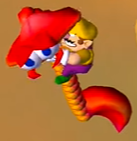Big Scorper: Difference between revisions
From the Super Mario Wiki, the Mario encyclopedia
Jump to navigationJump to search
No edit summary |
(There's hardly any connection to "scorpion") |
||
| (37 intermediate revisions by 19 users not shown) | |||
| Line 1: | Line 1: | ||
{{ | {{species infobox | ||
|image=[[File:Big Scorper.png]]<br>Wario picking up a Big Scorper | |||
|image=[[File: | |||
|first_appearance=''[[Wario World]]'' ([[List of games by date#2003|2003]]) | |first_appearance=''[[Wario World]]'' ([[List of games by date#2003|2003]]) | ||
| | |comparable=[[Stingray]] | ||
}} | |||
{{quote|The {{color|Big Scorpers|blue}} are so annoying when they burrow into the sand! I hate those things! Use a {{color|Ground Pound move to force 'em out|red}}!|Spriteling|Wario World}} | |||
'''Big Scorpers''' are enemies in ''[[Wario World]]'', found in [[Pecan Sands]]. They are big red scorpions with long tails, blue eyes, no claws, and small legs. They will attempt to strike at [[Wario]] with their tails if he stands on or near their heads. | |||
The only way to attack Big Scorpers is to use a [[Ground Pound]] on their heads, | The only way to attack Big Scorpers is to use a [[Ground Pound]] on their heads. After doing so three times, they will be knocked out of the sand and become vulnerable to Wario's attacks. | ||
==Names in other languages== | |||
{{foreign names | |||
|Jap=おおサソリ | |||
|JapR=Ō Sasori | |||
|JapM=Big Scorpion | |||
|Jap2=スカルゴ<ref>「ワリオワールド任天堂公式ガイドブック」 (''Wario World Nintendo Kōshiki Guidebook''), [[media:WW Shogakukan P157.jpg|page 157]].</ref> | |||
|Jap2R=Sukarugo | |||
|Jap2M=Possibly derived from "scarlet" and「御」(''-go'', an honorific suffix) | |||
|Ita=Scoprione Scarlatto | |||
|ItaM=Scarlet Scorpion | |||
}} | |||
== | ==Trivia== | ||
*The game's official European website erroneously gives the name "Big Scorper" to the [[Sandworm]] boss, despite it clearly not being a scorpion. Presumably, the writer of that section misinterpreted the [[Spriteling]]'s hint as referring to the boss instead of the enemy. | |||
==References== | ==References== | ||
<references/> | <references/> | ||
{{ | {{Wario World}} | ||
[[Category:Arachnids]] | |||
[[Category: | [[Category:Wario World enemies]] | ||
[[Category:Wario | |||
Latest revision as of 01:27, October 10, 2023
| Big Scorper | |||
|---|---|---|---|
 Wario picking up a Big Scorper | |||
| First appearance | Wario World (2003) | ||
| |||
- “The Big Scorpers are so annoying when they burrow into the sand! I hate those things! Use a Ground Pound move to force 'em out!”
- —Spriteling, Wario World
Big Scorpers are enemies in Wario World, found in Pecan Sands. They are big red scorpions with long tails, blue eyes, no claws, and small legs. They will attempt to strike at Wario with their tails if he stands on or near their heads.
The only way to attack Big Scorpers is to use a Ground Pound on their heads. After doing so three times, they will be knocked out of the sand and become vulnerable to Wario's attacks.
Names in other languages[edit]
| Language | Name | Meaning |
|---|---|---|
| Japanese | おおサソリ Ō Sasori スカルゴ[1] Sukarugo |
Big Scorpion Possibly derived from "scarlet" and「御」(-go, an honorific suffix) |
| Italian | Scoprione Scarlatto |
Scarlet Scorpion |
Trivia[edit]
- The game's official European website erroneously gives the name "Big Scorper" to the Sandworm boss, despite it clearly not being a scorpion. Presumably, the writer of that section misinterpreted the Spriteling's hint as referring to the boss instead of the enemy.